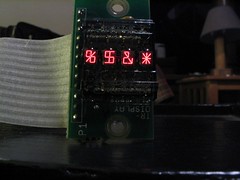HPDL-1414 Alphanumeric Display
I recently acquired a little gem from an old piece of equipment we were throwing away at work - that gem is the HPDL-1414 four character alphanumeric display. It is a small chip manufactured by Hewlett Packard that contains four tiny, red LED alphanumeric displays behind glass magnifying lenses. The chip itself is CMOS, however it runs at TTL voltages, making it easy to interface with. Interfacing is very simple from a logic level as well - simply set the write enable pin high (disable writing), set the 2 bit character address via the address lines, set the 7 bit ASCII value of the character via the data lines, pull the write pin low (enable write), rinse, lather, and repeat for each character. The only disadvantages that I have seen with this display are that it does not support full ASCII (capital letters and some symbols only), the characters are not very bright (although this could be because I'm not giving enough voltage to VDD (I'm currently running it off of the 5v from the parallel port to save wires), and the letters themselves are fairly tiny. Otherwise, this is a great little display that is very easy to work with and tons of fun to write software for.
Currently I have a few functions written in C to put characters at individual addresses, scroll a text string at arbitrary speed (from super, mind-numbingly fast, to as slow as you want), and just for fun a function that switches all of the segments from '1' to '/' to '-' to '\' fairly fast, producing a rather interesting and attention-grabbing spinner effect.
The physical aspects of the construction were fairly straight-forward: I hacked up an old parallel printer cable for the computer connection by using trial and error with a multimeter to find which wire goes to which pin; the case is, fairly obviously, an old Altoids tin which I Dremelled out to make a window and lined with electrical tape. I initially tried to make my parallel cable using a 25-pin header that I tried soldering phone cable to. I would not advise trying this, as phone cable insulation tends to melt at fairly low temperature making it very not-fun to solder. And - after I eventually did get all the little wires soldered at each end, one of my lines was goofed up preventing all of the characters from appearing, and generally frustrating me to the point where hacking up an old printer cable was rather cathartic. Just a word of warning.
So - if you can get your hands on one of these, by all means go for it - I'm sure that it would be very useful in any project for which you can spare a few data lines and want to add a really neat retro looking display to get some data to the user.
